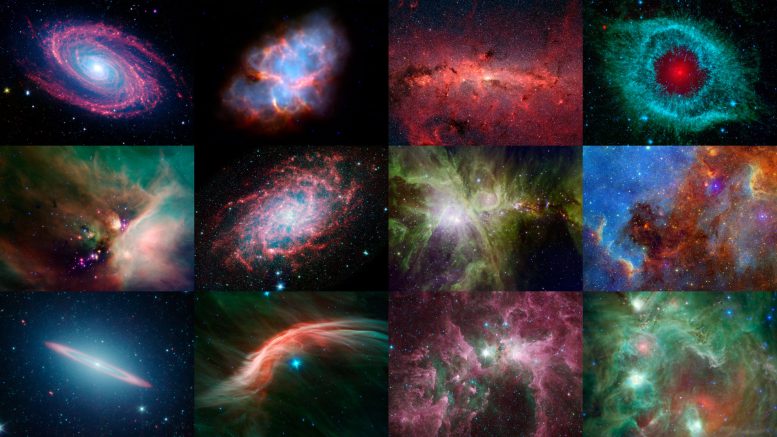
NASA’s Spitzer Space Telescope is celebrating 12 years in space with a new digital calendar. The calendar’s 12 images are shown here. Credit: NASA/JPL-Caltech
NASA has released a new digital calendar to celebrate the 12th anniversary of the Spitzer Space Telescope. The calendar showcases some of the mission’s most notable discoveries and popular cosmic images.
The digital calendar is online at: www.jpl.nasa.gov/images/spitzer/20150820/Spitzer12thAnniversaryCalendar.pdf (Update: Years later, this link no longer works.)
The calendar follows the life of the mission, with each month highlighting top infrared images and discoveries from successive years – everything from a dying star resembling the eye of a monster to a star-studded, swirling galaxy. The final month includes a brand new image of the glittery star-making factory known as the Monkey Head nebula.
“You can’t fully represent Spitzer’s scientific bounty in only 12 images,” said Michael Werner of NASA’s Jet Propulsion Laboratory in Pasadena, California, the mission’s project scientist and a Spitzer team member since 1977. “But these gems demonstrate Spitzer’s unique perspectives on both the nearest, and the most distant, objects in the universe.”
Spitzer, which launched into space on August 25, 2003, from Cape Canaveral, Florida, is still going strong. It continues to use its ultra-sensitive infrared vision to probe asteroids, comets, exoplanets (planets outside our solar system) and some of the farthest known galaxies. Recently, Spitzer helped discover the closest known rocky exoplanet to us, named HD219134b, at 21 light-years away.
In fact, Spitzer’s exoplanet studies continue to surprise the astronomy community. The telescope wasn’t originally designed to study exoplanets, but as luck – and some creative engineering – would have it, Spitzer has turned out to be a critical tool in the field, probing the climates and compositions of these exotic worlds. This pioneering work began in 2005, when Spitzer became the first telescope to detect light from an exoplanet.
Other top discoveries from the mission so far include:
- Recipe for “comet soup.” Spitzer observed the aftermath of the collision between NASA’s Deep Impact spacecraft and comet Tempel 1, finding that cometary material in our own solar system resembles that around nearby stars.
- The largest known ring around Saturn, a wispy, fine structure with 300 times the diameter of Saturn.
- First exoplanet weather map of temperature variations over the surface of a gas exoplanet. Results suggested the presence of fierce winds.
- Asteroid and planetary smashups. Spitzer has found evidence for several rocky collisions in other solar systems, including one thought to involve two large asteroids.
- The hidden lairs of newborn stars. Spitzer’s infrared images have provided unprecedented views into the hidden cradles where young stars grow up, revolutionizing our understanding of stellar birth.
- Buckyballs in space. Buckyballs are soccer-ball-shaped carbon molecules that have important technological applications on Earth.
- One of the most remote planets known, lying about 13,000 light-years away, deep within our galaxy. Spitzer continues to help in the search for exoplanets using a state-of-the-art method called microlensing.
- Massive clusters of galaxies. Spitzer has identified many more distant galaxy clusters than were previously known.
- “Big baby” galaxies. Spitzer and Hubble has found remote galaxies that were much more massive and mature than expected.

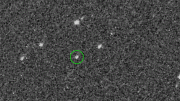



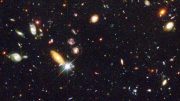
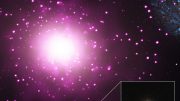

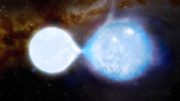
Be the first to comment on "New Digital Calendar Celebrates 12th Anniversary of the Spitzer Space Telescope"